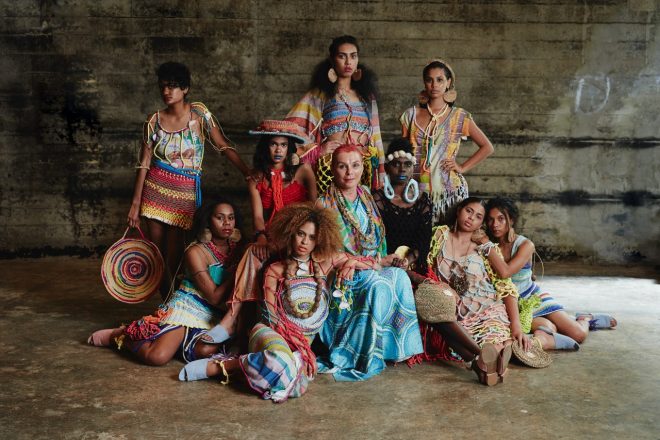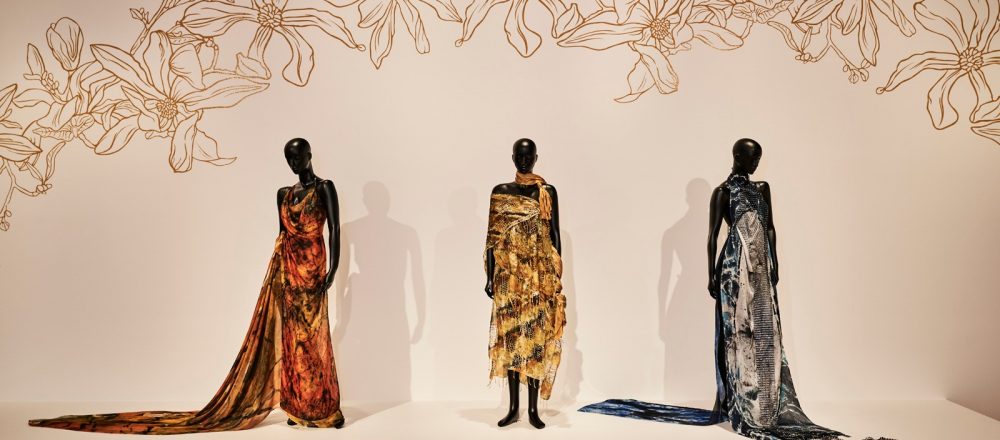Entering Bendigo Art Gallery’s main exhibition space, the Piinpi display feels like any other survey of contemporary haute couture. Slender mannequins line the walls with gossamer-like silk cascading from their shoulders, presenting the viewer with a striking display of wearable art that immediately captivates and excites.
What this exhibition truly explores, however, is revealed on closer inspection. Going far deeper than ostensible beauty and materialism, the unique compilation of works from over 70 Indigenous artists and designers expresses a connection to culture and Country through the lens of fashion, showcasing textiles and wearable art which are noticeably distinct from anything else being created globally.
Curated by Kaantju woman Shonae Hobson, the Gallery’s first-ever First Nations Curator, Piinpi, is a landmark exploration of the cultural importance of Indigenous seasonal knowledge, community connection and storytelling in a contemporary context.
‘Piinpi’, a Kuuku Ya’u phrase used to describe environmental cycles across the landscape, is a telling summation of the collection’s core. According to Hobson, “for centuries, Indigenous knowledge and connection to land has played a pivotal role in art and culture for Australia’s First Peoples”.
Structuring itself on the Kuuku Ya’u seasons, Hobson’s curation intends to take audiences across the land, creating a latticework of garments and designs which blur the line between tradition and modernity to tell stories of Country, culture and ancestral connection through methodically crafted fabrics and statement designs.

Standing tall at the exhibition’s entrance are the works of artist and designer Lyn-Al Young, a Gunnai, Waradjuri, Gunditjmara and Yorta Yorta woman who connects to her traditional Country in south-east Australia by creating pieces inspired by her ancestral lands. Commissioned specifically by the Gallery to create works which explore the exhibition’s themes of environmental flux, Young creates her works on her traditional Country while practising an ancient singing process, a method which allows for a deep spiritual connection to her cultural roots. The result is four mottled, deeply-hued garments which celebrate her Country’s bushland, its fires and its waterways, embedding powerful stories of human experience into the delicate ripples of painted silks. For artists like Young, creation is far more about the process than the final product.
In the space titled Piicha Piicha (the cool season), artists who employ recycled materials are showcased, using matter such as ocean debris to create considered fashion pieces while paying respect to the communities from which the materials were sourced.
The fusion of traditional techniques and modern mediums creates an interesting dual storyline; the artists connect to culture and heritage while simultaneously exploring new avenues for individual expression.
In the Ngurkitha space (the season of rain), the application by artists of paint directly onto fabric parallels other traditional practices such as burrkunda (body painting), which connects the women to their families. Comprised of garments that employ vibrant colour palettes and semi-abstract lines which imitate local marine systems, the collection forms a kaleidoscope of energy, freedom of expression and whimsicality, encapsulating the celebration of culture and modern artistry which Piinpi embodies.
Building on this sense of contemporary expressionism comes the final space, titled Blak and Deadly. Straying from the theme of seasonal knowledge and shift, this space showcases artists working in urban environments who manifest bold and powerful forms of resistance through design.
For Bardi artist Teagan Cowlishaw, the connection between creative spirit and culture has led her to blend art and textile, creating fierce pieces such as Deadly Kween, a black sequined jumpsuit made from upcycled materials with the phrase ‘DEADLY’ stamped on its back. The piece is one of many within the space which exemplifies Indigenous empowerment, illustrating the ongoing resilience of the artists who are reclaiming and redesigning a sense of what it means to be Indigenous Australian through the medium of fashion.
This cache of Indigenous designers is significant in the way it redefines Australian fashion. Contrasting to the ideology of the Western fashion industry, which is predominantly focused on fast fashion and mass consumerism, the pieces within the collection go beyond the concept of fashion for beauty. Rather, they emphasise the importance of slow fashion and sustainability, each product prioritising process, storytelling and respect for materials over allegiance to superficial trends.
As the first exhibition in the Bendigo Art Gallery to be curated by a First Nations person, Piinpi represents a monumental moment in the reclamation of the Indigenous narrative. As Hobson said:
“For so long, our stories and histories have been told through the lens of the coloniser.”
The impact of this unique showcase of artists, designers, innovators and cultural leaders extends beyond the mere fanciful escapism with which its mesmerising patterns so easily tempt us. Hobson’s curation is an invaluable reinforcement of Indigenous voice and visibility in Australian culture, a presence which has too often been muffled in the colonial landscape.


